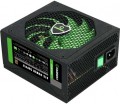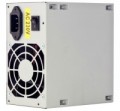Power
The output power of the power supply, in other words, is the maximum power that it is capable of delivering to the system. For the computer to operate efficiently, the power supply must be greater than the total power consumption of the system at maximum load. The latter can be calculated by summing the power of individual components, however, in general, for office configurations
, about 400 W —
450 W is considered sufficient, for medium gaming — about
600 W(
500 W,
550 W,
650 W,
700 W,
750 W), and for the top ones —
power of 800 W and above (
850 W,
1000 W and even
more than 1 kW).
PFC
The type of power factor correction (PFC) provided in the power supply.
The power consumed by the PSU is divided into
active and reactive; the first goes to perform useful work, the second does not produce such work and is dissipated in the form of heat. The power factor is the ratio of active power to the total power consumed; the closer it is to one, the more efficient the PSU.
PFC correction is applied to improve the power factor. It can be done passively or actively. The first option provides the presence of a coil (choke), which partly compensates for the operation of the reactive components of the PSU; such a correction is simple and inexpensive to implement, but not very effective. The active method, in turn, provides the presence of a specialized controller. It is more expensive, but the power factor in such PSUs can reach 0.95 or more; in addition, the device is more resistant to voltage drops.
In general, for use in a home or small office, passive correction is more than enough; active PSUs should be specifically looked for mainly in cases where we are talking about numerous computers connected to a powerful UPS.
Fan size
The diameter of the fan(s) in the power supply cooling system.
The large diameter allows to achieve good efficiency at relatively low RPMs, which in turn reduces noise and power consumption. On the other hand, large fans are more expensive than small ones and take up a lot of space, which affects the dimensions of the entire PSU. We also emphasize that a small fan is not yet a sign of a cheap power supply — quite advanced models can also have such equipment, in order to reduce dimensions.
As for specific diameters, the smallest value that can be found in modern consumer-grade PSUs is
80 mm. The most popular option is
120 mm, this size gives good efficiency and a relatively low noise level at a reasonable price and dimensions. Larger diameters are somewhat less common —
135 mm and
140 mm.
Certification
The presence or absence of an 80+ certificate for the power supply. This certificate indicates high energy efficiency: to obtain it, the efficiency (see above) must be at least 80%, and in different modes (20%, 50% and 100% of the maximum load). There are several degrees of 80+:
—
80+. The original version of the certificate, assuming an efficiency of at least 82% (at least 85% for 50% load).
—
80+ White. The second name of the original 80+ certificate (see above).
—
80+ Bronze — efficiency not less than 85% (for half load — 88%).
—
80+ Silver — respectively 87% (90% for half load).
—
80+ Gold — 89% (92% for half load)
—
80+ Platinum — 90% (94% for half load).
—
80+ Titanium — 94% (96% for half load).
The power factor (see "PFC Type") must be at least 0.9 for the lower levels and at least 0.95 for the Platinum level. Also note that for redundant power used in server systems, the efficiency requirements are somewhat lower.
ATX12V version
A standard for power supplies that supplements the ATX specifications regarding power supply along the 12 V line. Introduced into use since the time of the Intel Pentium 4 processor. In the first series of the standard, the +5 V line was mainly used; from version 2.0, the +12 V line was introduced to fully power the components computer. Also in the second generation, a 24-pin power connector appeared, used in most modern motherboards.
PCI-E 6pin
The number of 6-pin (6pin) PCI-E power connectors provided in the power supply.
Such connectors are used for additional power supply of those types of internal peripherals for which 75 W is no longer enough, supplied directly through the PCI-E socket on the motherboard (video cards are a typical example). The 6-pin connector on the power supply additionally provides another 75 W — thus, when using this connector, it becomes possible to connect boards with a power consumption of up to 150 W.
Note that some video cards have several connectors for additional power at once. Thus, the PSU can provide both
one PCI-E 6pin plug, and
two such connectors. However, in general, this type of plug is used quite rarely — this is due to the spread of a more convenient and versatile 8pin connector in the “6 + 2” format, which can be used both as six- and eight-pin (see below for more details).
+3.3V
The maximum values of current and power that the PSU can provide on individual power lines.
The power line can be simply described as a pair of contacts for connecting a particular load; one of these contacts is “ground” (with zero voltage), and the second has a certain voltage with a plus or minus sign, this voltage corresponds to the voltage of the power line. In this paragraph, it is + 3.3V (such power is present in 20- and 24-pin connectors for motherboards, in SATA power connectors and some other types of connectors).
In general, power and currents are rather specific parameters that the average user rarely needs — mainly when connecting high-power components such as video cards, as well as when starting a PSU without a computer to power other electronics (for example, amateur radio stations). It is also worth mentioning that the sum of the maximum powers on all lines can be higher than the total output power of the PSU — this means that all lines cannot operate at full power at the same time. Accordingly, when the PSU is fully loaded, some of them will produce less power than the maximum possible.
+5V
The maximum current that the PSU is capable of issuing + 5V to the power line. For more information about power lines in general, see "+3.3V". Also note here that + 5V power, in addition to connectors for motherboards (for 20 and 24 pins), is also found in Molex and SATA plugs, as well as some other specific types of connectors.
+12V1
The maximum current that the PSU is capable of delivering to the first power line is + 12V.
For more information about power lines in general, see "+3.3V". Here it is worth mentioning that 12 V is the most popular voltage among computer power connectors. It is used in almost all such connectors (with a few exceptions), and some plugs (for example, additional PCI-E power for 6 or 8 connectors) use only 12-volt lines — and in the + 12V format. And the division of + 12V power into several separate lines is used for safety purposes — in order to reduce the current flowing through each individual wire, and thus prevent excessive load and overheating of the wiring. However, some manufacturers do not specify the maximum current for individual + 12V lines and give only a general value in the characteristics; in such cases, this number is indicated in this paragraph.

